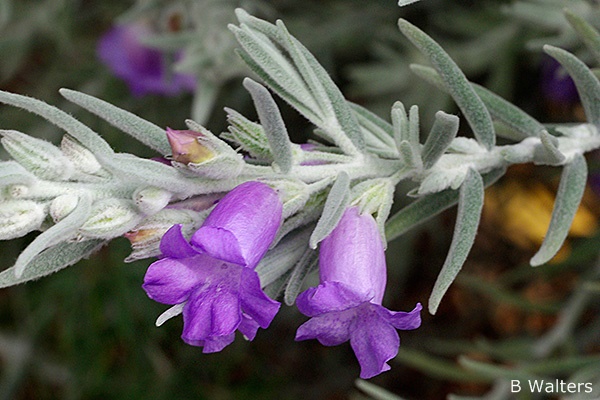General Description:
Eremophila is a large genus of 214 species, all endemic to Australia. They are generally plants of inland and arid areas and are popular with Australian plant enthusiasts.
Eremophila nivea is a small shrub to about 1 -1.5 metres high by a similar width. It has very hairy stems and foliage giving the plant a very distinctive silvery appearance. The soft leaves are linear to lance-shaped to about 30 mm long by 4 mm wide. The mauve or lilac coloured flowers are about 20 mm long and tubular in shape. Flowers are seen from late winter to early summer. The fruits are egg shaped and about 6 mm long.
E.nivea is one of the most spectacular members of the genus. It has been in cultivation for many years but, like most eremophilas, it is best suited to dry climates in well drained soils. It can be difficult to grow in more humid, temperate areas although many people take up the challenge! In those areas, the hairy foliage is subject to fungal diseases which are difficult to control. To maximise the chances of success, the plant should be grown in an open, sunny position with good air circulation and the foliage should be kept as dry as possible. Although most plants sold are grafted to improve the hardiness and vigour of the plant, this does not fully overcome foliage problems. The plant is reported to be frost sensitive. Cultivation of the E.nivea in a container probably provides the best chance of success in humid climates as this makes it easier to provide the necessary growing conditions.
Propagation from seed of Eremophila species is unreliable. A number of treatment methods have been tried including sowing the ripe fruits, sowing of aged and washed fruits and splitting the fruits to extract the seeds prior to sowing. The latter involves splitting the fruits in halves and quarters but some seeds are inevitably damaged during the process.
E.nivea can be grown from cuttings but the foliage may easily rot under misting conditions. Grafting onto a Myoporum rootstock is the preferred method of propagation.
* EPBC Act = Environment Protection and Biodiversity Conservation Act 1999;
ROTAP = Rare or Threatened Australian Plants (Briggs and Leigh, 1988)
For further information refer the Australian Plants at Risk page

Eremophila nivea
Photo: Brian Walters
Images of all Eremophila species, hybrids and cultivars can be seen in the Eremophila Study Group’s Eremophila Image Database
 Australian Native Plants Society (Australia)
Australian Native Plants Society (Australia)